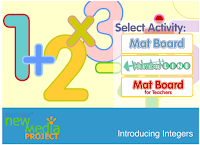Ok, my post today was supposed to be about using 3D technology in the classroom, but I was distracted by something my sister and I were discussing this morning. My sister is a middle school math/science teacher and for some unfathomable reason, we began talking about math fluency in middle school. We chatted about the merits of informally assessing math skills in order to redress weaknesses and capture quantifiable data for progress reports. We agreed that just as reading fluency impacts a student's ability to comprehend text, math fluency impacts a student's ability to comprehend the language of numbers. Both areas require a solid base upon which to build more advanced concepts.
I remarked that there are several informal assessments to track fluency and comprehension for reading, but there appeared to be a dearth of informal resources to assess math fluency. Why is this? Is it that reading fluency is more important than math fluency? We have a QRI, why not a QMI?
I hung up with my sis, and being the technophile that I am, I began searching the web for informal math assessments for middle school and high school students. I trolled the internet for 3 hours...and came up with next to nothing. I found many informal inventories for grades K- 6, and only one honorable mention for grades K - 8 (Scholastic Math Inventory by Tom Snyder ). Nothing for grades 6-12. Back to square one.
I did find a few math related gems on the web today, so my searching wasn't a total loss.
UEN 7-12 Student Interactives is a free website developed by the Utah Education Network for students grades 7-12. The UEN site has links to math, science, ELA, social studies, lesson plans, video resources, worksheets and more. The math practice for upper level math students includes activities for algebra, geometry, data/probability, number sense and money skills. Each topic area has a variety of activities that are attractive, interactive and engaging. What I like about this website is that each activity displays and has links to the necessary video drivers to run effectively. Take some time to explore this website, it is well worth it! The activities for Geometry and Data/Probability are detailed below. Click on the picture to link to the math activities.
My second find was the MathStar website, created by the Los Angeles County Office for Education. This site has interactive activities for students, lesson plans and resources for teachers, worksheets, and discussions. The site did have a few broken links, but overall it is a great resource for middle school math teachers and students.
Try the Mat Board Activity:
My next blog will cover 3D technology and its educational applications. Enjoy!







This is a question we ponder at the elementary level as well. We are all making our own informal assessments. However, that being said I believe there is more out there on the web for elementary Math.
ReplyDeleteI say that we need to restructure our day so that we have more math time. At present we are only required to teach 60 min of math per day. This is not nearly enough for fluency, problem solving, et al.
Thanks for sharing!
Thanks Nancy, I agree that more time should be devoted to math fluency starting at the elementary level. This would certainly help improve understanding of concepts at the middle school level. Automaticity of math facts would lessen the amount of energy expended when solving more complex math. Thanks for the post Nancy!
ReplyDelete